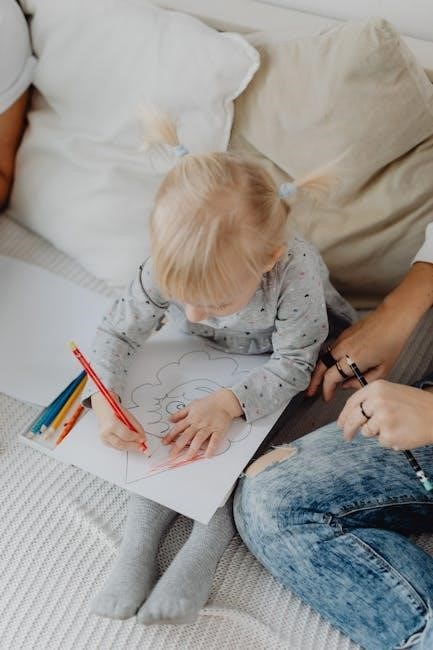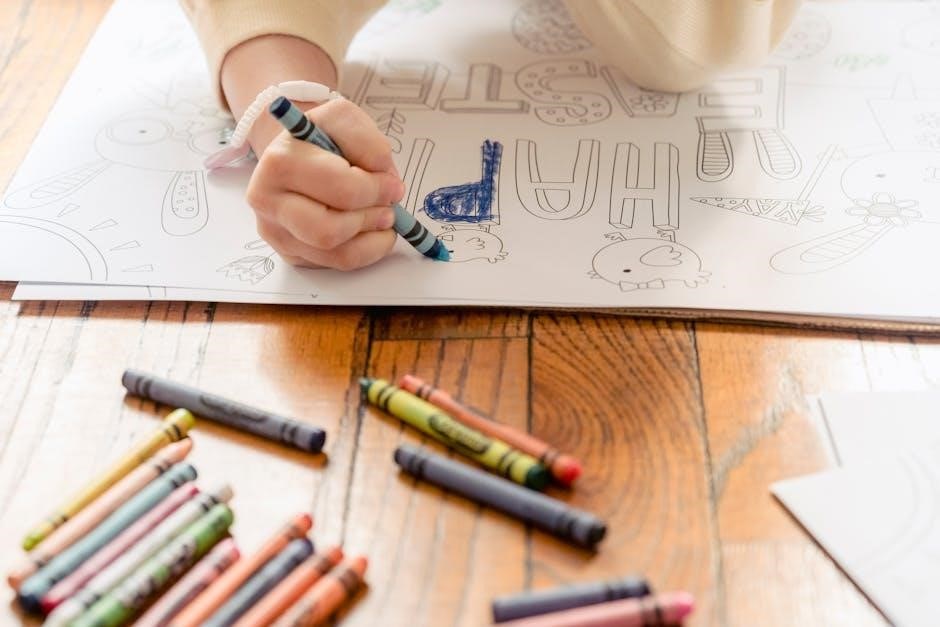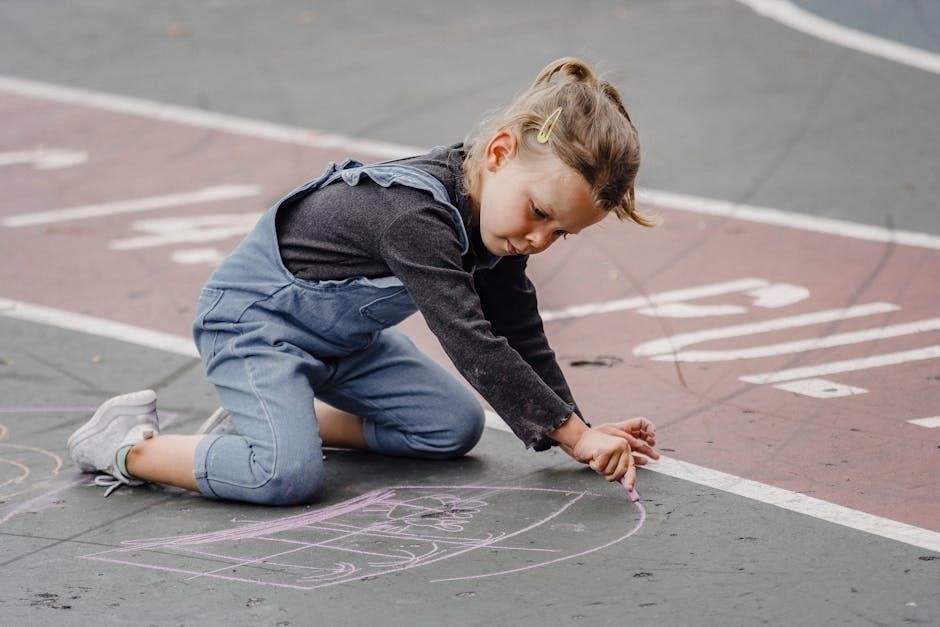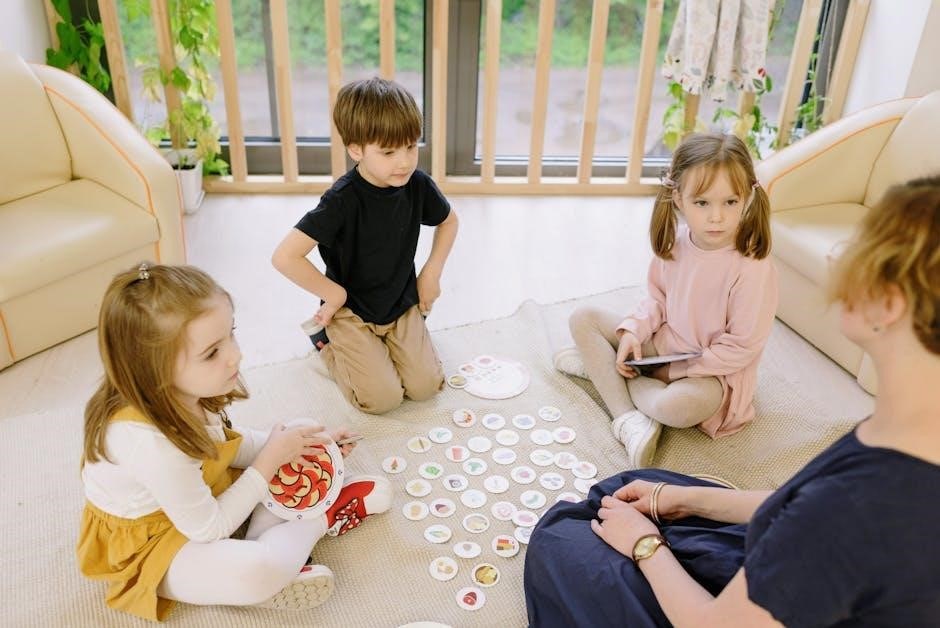
Listen and draw activities are interactive tasks where participants create artwork based on verbal instructions, fostering creativity and listening skills. These exercises are simple, engaging, and effective for cognitive development, making them popular in educational settings.
1.1 What Are Listen and Draw Activities?
Listen and draw activities involve participants creating artwork based on verbal instructions, enhancing creativity and listening skills. They are widely used in educational settings to engage students, promote cognitive development, and foster artistic expression. These tasks are simple yet effective, encouraging focus, imagination, and the ability to follow directions. They are adaptable to various age groups and learning levels, making them a versatile tool for educators.

1.2 Benefits of Listen and Draw for Learning and Development
Listen and draw activities enhance listening skills, creativity, and focus. They help students interpret verbal instructions accurately, fostering critical thinking and vocabulary expansion. These tasks also improve fine motor skills through drawing, encouraging self-expression. By linking auditory input to visual output, they strengthen cognitive connections, making them an effective tool for language learners and young children. They also promote patience and attention to detail, aiding overall academic development.
Purpose and Goals of Listen and Draw Instructions
The purpose of listen and draw instructions is to enhance listening, creativity, and comprehension skills. They help build focus, self-expression, and the ability to follow directions effectively.
2.1 Developing Listening Skills Through Art
Listen and draw activities are designed to refine auditory processing and attention. By following verbal instructions, participants improve comprehension, memory, and the ability to translate sounds into visual representations, enhancing their listening skills through creative expression and focus.
2.2 Enhancing Creativity and Fine Motor Skills
Listen and draw activities stimulate creativity by allowing participants to interpret instructions uniquely, fostering original ideas. The process of drawing enhances fine motor skills, as it requires precise hand movements, improving dexterity and coordination. This combination of artistic expression and physical skill development makes the activity engaging and beneficial for overall growth.

Preparing for the Activity
Prepare materials like paper, colors, and tools. Ensure a quiet, distraction-free environment to help students focus and engage effectively with the listen-and-draw instructions provided.
3.1 Gathering Materials and Tools
Gathering the right materials is crucial for a successful listen-and-draw activity. Ensure each participant has paper, colored pencils, markers, or crayons. Additional tools like erasers and sharpeners can be helpful. Organize these materials in an accessible manner to avoid delays. Having extra supplies on hand ensures everyone can fully engage without interruptions. A well-prepared setup fosters creativity and focus, making the activity more enjoyable and productive for all involved.
3.2 Setting Up the Environment for Focus
Creating a conducive environment is essential for listen-and-draw activities. Ensure the space is quiet and free from distractions. Arrange seating to allow students to focus on the speaker and their artwork. Use visual aids like charts or examples to guide their attention. Proper lighting and comfortable seating can enhance concentration. A well-organized setup helps students stay engaged and fully immerse in the task, fostering better comprehension and creativity.

Delivering Clear Instructions
Clear instructions are vital for effective listen-and-draw activities. Use structured verbal commands and visual aids to ensure comprehension. Break tasks into steps to maintain engagement and focus.
4.1 Structuring Verbal Commands for Clarity
Structuring verbal commands clearly involves breaking instructions into simple, sequential steps. This ensures participants can follow without confusion. Using specific language and pausing between steps helps with comprehension. Demonstrating actions or providing examples enhances understanding, especially for visual learners. Clear commands also reduce errors and keep the activity flowing smoothly, making it more enjoyable and effective for everyone involved in the task at hand.
4.2 Using Visual Aids to Support Listening
Visual aids enhance listening comprehension by providing a reference point for participants. Images, diagrams, or gestures can clarify complex instructions, helping individuals visualize the task. This dual approach—combining verbal and visual cues—engages both auditory and visual learners, reducing misunderstandings. Visual aids also serve as reminders, allowing participants to check their work as they progress, ensuring accuracy and boosting confidence throughout the activity. They are particularly beneficial for younger or less experienced learners. Digital tools like slides or videos can further enrich the experience. Consistent use of visual aids fosters a supportive and inclusive environment, making the activity more accessible and enjoyable for all participants. This method is especially effective in diverse learning settings, where varying abilities and preferences exist. By integrating visual elements, instructors can cater to different learning styles, promoting better retention and overall success of the task. The combination of clear verbal commands and visual support creates a comprehensive learning experience that engages multiple senses and enhances understanding.

Executing the Listen and Draw Task
Executing the listen and draw task involves guiding participants through structured steps, ensuring they interpret instructions accurately. Clear verbal cues and visual aids help maintain focus and engagement, fostering creativity and precision in their artwork. This phase is crucial for assessing comprehension and encouraging imaginative expression. It also allows for real-time adjustments to support diverse learning needs and maintain a productive environment. The process emphasizes active listening and the application of instructions, making it a dynamic and interactive experience. By breaking down complex commands into manageable parts, participants can confidently create their artwork while developing essential skills. This step is where creativity and understanding converge, leading to meaningful outcomes for all involved. The execution phase is a blend of instruction, creativity, and critical thinking, ensuring participants stay engaged and motivated throughout the activity. Effective execution relies on clear communication and supportive guidance, enabling participants to produce their best work. The combination of listening and drawing fosters a deeper connection between auditory input and visual output, enhancing overall learning and enjoyment. Through this process, participants not only complete the task but also develop valuable skills in following directions and expressing ideas creatively. The execution phase is a cornerstone of the listen and draw activity, where preparation meets practice, and learning becomes fun and interactive. By focusing on clear instructions and creative expression, this phase ensures a rewarding experience for all participants. The listen and draw task execution is a well-structured approach that combines auditory and visual learning, making it an effective tool for diverse educational settings. It encourages active participation, critical thinking, and artistic exploration, providing a comprehensive learning experience. The process is adaptable to various age groups and skill levels, ensuring inclusivity and engagement for everyone involved. By emphasizing both listening and creativity, the task execution phase supports holistic development and fosters a sense of accomplishment in participants. This phase is where the foundation of the activity is put into practice, resulting in tangible and often impressive creative outcomes. The execution of the listen and draw task is a testament to the power of combining auditory and visual learning strategies, creating a memorable and impactful experience. Through careful guidance and supportive techniques, participants are empowered to bring their interpretations to life, making the activity both educational and enjoyable. The execution phase is a critical component of the listen and draw process, where instruction, creativity, and skill-building converge to create a dynamic and engaging experience. By focusing on clear communication and artistic expression, this phase ensures that participants not only meet the task’s objectives but also gain valuable skills that extend beyond the activity itself. The listen and draw task execution is a celebration of creativity and understanding, where participants’ unique interpretations shine, making every outcome a testament to their individuality and learning. This phase is where the listen and draw activity truly comes alive, transforming simple instructions into vibrant works of art that reflect each participant’s personal style and comprehension. The execution phase serves as a reminder of the importance of clear instructions and creative freedom, allowing participants to thrive in a supportive and engaging environment. By fostering both listening and creativity, the task execution phase ensures that participants leave with a sense of accomplishment and newfound confidence in their abilities. The listen and draw task execution is a powerful example of how structured activities can promote learning, creativity, and fun, making it a valuable tool for educators and facilitators alike. This phase is where the magic happens, turning auditory instructions into visual masterpieces that tell a story of understanding and imagination. The execution of the listen and draw task is a testament to the effectiveness of combining auditory and visual learning, resulting in a rich and rewarding experience for all participants. By focusing on clarity, creativity, and support, the task execution phase ensures that every participant can excel and enjoy the process of bringing their ideas to life. This phase is a celebration of the intersection of listening and artistry, where participants’ unique voices are expressed through their creations, making each piece a reflection of their journey and growth. The execution phase is a cornerstone of the listen and draw activity, providing a platform for participants to showcase their skills, creativity, and understanding in a fun and interactive way. By emphasizing both auditory and visual elements, this phase ensures a well-rounded learning experience that is both memorable and impactful. The listen and draw task execution is a dynamic and engaging process that fosters creativity, critical thinking, and active listening, making it an invaluable tool for educational and creative development. This phase is where participants’ hard work and dedication come to fruition, resulting in a sense of pride and accomplishment that extends beyond the activity itself. The execution phase is a shining example of how structured, engaging activities can promote holistic development, making the listen and draw task a beloved and effective learning tool. By combining clear instructions with creative freedom, the task execution phase empowers participants to express their unique perspectives, fostering a sense of community and shared achievement. This phase is where the listen and draw activity reaches its full potential, transforming simple instructions into meaningful works of art that reflect the diversity and talent of the participants. The execution phase is a critical component of the listen and draw process, ensuring that every participant’s voice is heard and their creativity is unleashed, resulting in a truly enriching experience. By focusing on clear communication and artistic expression, the task execution phase creates a supportive environment where participants can thrive and produce their best work. This phase is a celebration of creativity, understanding, and growth, making the listen and draw task a cherished and effective learning activity for all involved. The execution phase is where the listen and draw activity comes full circle, turning auditory instructions into visual stories that capture the essence of each participant’s journey and learning. By emphasizing both auditory and visual elements, this phase ensures a comprehensive and engaging experience that fosters creativity, critical thinking, and active listening. The listen and draw task execution is a powerful example of how educational activities can be both fun and impactful, leaving a lasting impression on participants and enhancing their skills in meaningful ways. This phase is a testament to the effectiveness of combining structured instructions with creative expression, resulting in a dynamic and rewarding experience for everyone involved. By focusing on clarity, support, and creativity, the task execution phase ensures that participants not only complete the activity but also gain valuable skills that extend beyond the task itself. The listen and draw task execution is a celebration of learning, creativity, and individuality, where participants’ unique interpretations and talents are showcased, making every outcome a testament to their personal growth and understanding. This phase is a cornerstone of the listen and draw activity, providing a platform for participants to express themselves, develop their skills, and enjoy the process of creating something meaningful. By combining auditory and visual learning strategies, the task execution phase ensures a well-rounded and engaging experience that is both educational and enjoyable. The listen and draw task execution is a dynamic and interactive process that fosters creativity, critical thinking, and active listening, making it an invaluable tool for educational and creative development. This phase is where participants’ efforts and creativity come together, resulting in a sense of pride and accomplishment that extends beyond the activity itself. The execution phase is a shining example of how structured, engaging activities can promote holistic development, making the listen and draw task a beloved and effective learning tool. By emphasizing both auditory and visual elements, this phase ensures a comprehensive and impactful experience that fosters creativity, understanding, and growth. The listen and draw task execution is a testament to the power of combining clear instructions with creative freedom, allowing participants to thrive and produce their best work. This phase is a celebration of the intersection of listening and artistry, where participants’ unique voices are expressed through their creations, making each piece a reflection of their journey and growth. The execution phase is a critical component of the listen and draw process, providing a platform for participants to showcase their skills, creativity, and understanding in a fun and interactive way. By focusing on clarity, support, and creativity, the task execution phase ensures that every participant can excel and enjoy the process of bringing their ideas to life. This phase is where the listen and draw activity truly comes alive, turning auditory instructions into vibrant works of art that tell a story of understanding and imagination. The listen and draw task execution is a powerful example of how structured activities can promote learning, creativity, and fun, making it a valuable tool for educators and facilitators alike. This phase is where the magic happens, turning simple instructions into meaningful works of art that reflect each participant’s personal style and comprehension. The execution phase is a cornerstone of the listen and draw activity, ensuring that participants not only meet the task’s objectives but also gain valuable skills that extend beyond the activity itself. By fostering both listening and creativity, the task execution phase ensures that participants leave with a sense of accomplishment and newfound confidence in their abilities. The listen and draw task execution is a dynamic and engaging process that combines auditory and visual learning, resulting in a rich and rewarding experience for all participants. By emphasizing clear instructions and creative expression, this phase ensures that every participant’s voice is heard and their creativity is unleashed, leading to a truly enriching experience. The listen and draw task execution is a testament to the effectiveness of combining structured instructions with creative freedom, empowering participants to express their unique perspectives and talents. This phase is a celebration of creativity, understanding, and growth, making the listen and draw task a cherished and effective learning activity for all involved. The execution phase is where the listen and draw activity reaches its full potential, transforming simple instructions into meaningful works of art that capture the essence of each participant’s journey and learning. By focusing on clarity, support, and creativity, the task execution phase creates a supportive environment where participants can thrive and produce their best work. This phase is a shining example of how educational activities can be both fun and impactful, leaving a lasting impression on participants and enhancing their skills in meaningful ways. The listen and draw task execution is a powerful example of how structured activities can promote holistic development, making it a beloved and effective learning tool for educators and facilitators alike. By combining auditory and visual learning strategies, the task execution phase ensures a comprehensive and engaging experience that fosters creativity, critical thinking, and active listening. This phase is where participants’ unique interpretations and talents are showcased,
and Reflection
5.1 Guiding Students Through the Drawing Process
Guiding students through the drawing process involves providing clear, step-by-step instructions and demonstrations. Use verbal cues and visual aids to ensure understanding. Break tasks into manageable steps, allowing students to follow along at their own pace. Encourage creativity while maintaining focus on the instructions. Offer support for those who need it, and allow time for questions. Positive reinforcement helps build confidence and keeps students engaged throughout the activity.